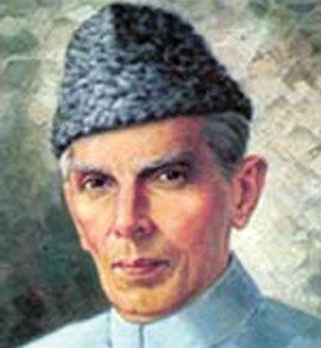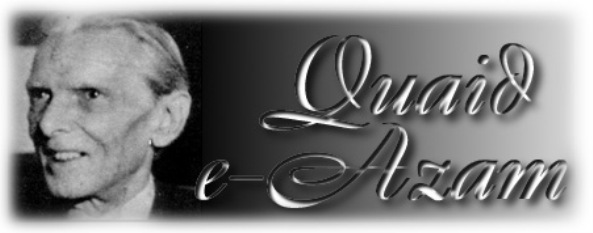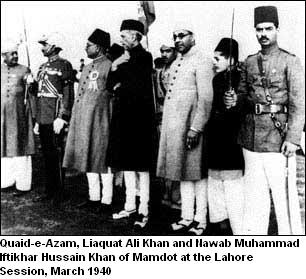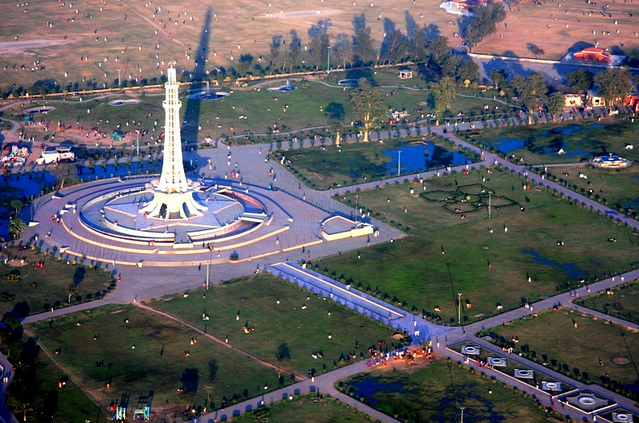Showing posts with label 1940. Show all posts
Showing posts with label 1940. Show all posts
Quaid-e-Azam turned a dream into a reality
ON March 23, 1940, the Muslims of the sub-continent resolved to create a separate homeland, Pakistan. The decision was neither taken in haste nor precipitated by a sudden, dramatic turn of events.
Hindus and Muslims had lived in India for centuries but had remained two distinctly different cultural entities presenting marked dissimilarities that neither time nor assimilation could erase; they were like two streams running a parallel course. So manifest and so profound were the differences that the London Times, commenting on the Government of India Act of 1935, had to ungrudgingly concede: “Undoubtedly the difference between the Hindus and Muslims is not of religion in the strict sense of the word but also of laws and culture, that they may be said indeed to represent two entirely distinct and separate civilizations.”
This incontrovertible realization found a more convincing elucidation in the words of Quaid-e-Azam Muhammad Ali Jinnah: “Notwithstanding thousand years of close contact, nationalities which are as divergent today as ever, cannot at any time be expected to transform themselves into one nation merely by mean of subjecting them to a democratic constitution and holding them forcibly together by unnatural and artificial methods of British Parliamentary Statutes.”
The background of Pakistan Resolution is such that in 1937, provincial autonomy was introduced in the sub-continent under the Government of India Act, 1935. The elections of 1937 provided the Congress with a majority in six provinces, where Congress governments were formed. This led to the political, social, economic and cultural suppression of the Muslims in the Congress ruled provinces.
The Congress contemptuously rejected the Muslim League’s offer of forming coalition ministries. The Muslims were subjected not only to physical attacks but injustice and discriminatory treatment as regards civil liberties, economic measures and employment and educational opportunities. The Congress Ministries introduced the Wardha scheme of education, the object of which was to “de- Muslimize” the Muslim youth and children.
Ian Stephens, former editor of the newspaper “Statesman” and an eyewitness to the working of the Congress Ministries, says: "The effect of this simultaneously on many Muslim minds was of a lightning flash.
Hindus and Muslims had lived in India for centuries but had remained two distinctly different cultural entities presenting marked dissimilarities that neither time nor assimilation could erase; they were like two streams running a parallel course. So manifest and so profound were the differences that the London Times, commenting on the Government of India Act of 1935, had to ungrudgingly concede: “Undoubtedly the difference between the Hindus and Muslims is not of religion in the strict sense of the word but also of laws and culture, that they may be said indeed to represent two entirely distinct and separate civilizations.”
This incontrovertible realization found a more convincing elucidation in the words of Quaid-e-Azam Muhammad Ali Jinnah: “Notwithstanding thousand years of close contact, nationalities which are as divergent today as ever, cannot at any time be expected to transform themselves into one nation merely by mean of subjecting them to a democratic constitution and holding them forcibly together by unnatural and artificial methods of British Parliamentary Statutes.”
The background of Pakistan Resolution is such that in 1937, provincial autonomy was introduced in the sub-continent under the Government of India Act, 1935. The elections of 1937 provided the Congress with a majority in six provinces, where Congress governments were formed. This led to the political, social, economic and cultural suppression of the Muslims in the Congress ruled provinces.
The Congress contemptuously rejected the Muslim League’s offer of forming coalition ministries. The Muslims were subjected not only to physical attacks but injustice and discriminatory treatment as regards civil liberties, economic measures and employment and educational opportunities. The Congress Ministries introduced the Wardha scheme of education, the object of which was to “de- Muslimize” the Muslim youth and children.
Ian Stephens, former editor of the newspaper “Statesman” and an eyewitness to the working of the Congress Ministries, says: "The effect of this simultaneously on many Muslim minds was of a lightning flash.
Rajgopalacharya has no mind
 |
| C Rajgopalacharya with the Quaid-e-Azam |
In the course of his statement on the Pakistan Resolution Mr. Rajgopalacharya said “Indeed not even Tipu Sultan or Hyder Ali or Aurangzeb or Akbar, all of whom lived during the days when difference seemed more deep rooted than now, imagined that India was anything but one and indivisible.”
On his Quaid-i-Azam observed: “Yes, naturally they did so as conquerors and paternal rulers. Is this the kind of government Mr. Rajagopalachrya does still envisage? And did the Hindus of those days willingly accept the rule of these ‘great men?’ I may or may not be suffering from a diseased mentality, but the statement of Mr. Rajagopalcharya and his criticism of the Lahore Resolution indicate that in him there is no mind left at all.”
Timeline of Quaid-e-Azam
Quaid-e-Azam
| December 25, 1876 | Born at Karachi |
| 1882 | Education started at home |
| 1887 | Admitted to Sind Madrasatul Islam, Karachi |
| 1892 | Married Emibai at the age of 16 Left Karachi for Europe |
| 1893 | Joined Lincoln's Inn Emibai died at home |
| 1895 | Became Bar-at-Law Mother died at Karachi |
| 1896 | Returned to Karachi from London Migrated to Bombay |
| 1897 | Enrolled as Advocate in Bombay High Court |
| 1900 | Appointed Presidency Magistrate, Bombay |
| 1906 | Appointed Personal Secretary to Dadabhoy Naoroji |
| 1909 | Father died Elected to the Supreme Imperial Council uncontested |
| 1910 | Elected to the Legislative Assembly, Bombay |
| 1911 | Piloted Waqf Alal Aulad Bill -- the only private member's Bill to be passed (in 1913) |
| 1912 | Attended All-India Muslim League Council Meeting |
| 1913 | Left for England with Gokhale Founded London Indian Association Joined All-India Muslim League |
| 1915 | Initiated the move for setting up of a League-Congress joint committee for Hindu-Muslim unity |
| 1916 | Presided over the sixteenth Bombay Provincial Conference Presided over the All-India Muslim League Lucknow session; Lucknow Pact signed |
| 1917 | Became President, Home Rule League, Bombay Organised "Memorandum of the Nineteen |
| 1918 | Married Rattenbai at Calcutta Foiled the move to set up "Willingdon Memorial" in Bombay. Jinnah's People's Memorial Hall constructed as a tribute to his services. |
| 1919 | Daughter (Dina) born Resigned from the Imperial Legislative Council as a protest against Rowlatt Act |
| 1920 | Resigned from Home Rule League Resigned from the Congress on differences with Gandhi |
| 1922 | Participated in All Parties Conference in Bombay as one of the three Secretaries |
| 1923 | Elected to the Imperial Legislative Council from Bombay |
| 1924 | Presided over the All-India Muslim League session in Lahore |
| 1927 | Boycotted the Simon Commission. Presided over a meeting of all the important Muslim leaders at Delhi |
| 1928 | Attended National Convention at Calcutta |
| 1928 | Rattenbai died |
| 1929 | Jinnah's amendments to Nehru Report rejected All-India Muslim League rejects Nehru Report at its Delhi session Jinnah's Fourteen Points |
| 1930 | Attended Round Table Conference in London |
| 1931 | Stayed on in England; gave up political activities temporarily |
| 1934 | Returned to India. Got actively engaged in politics Again elected to the Central Legislative Assembly Elected Permanent President of All-India Muslim League Elected leader of the Independent Party in the Assembly |
| 1935 | Government of India Act, 1935 passed Jinnah-Rajendra Prasad Formula |
| 1936 | Constituted All-India Muslim League Central Parliamentary Board to fight elections under 1935 Act |
| 1937 | Provincial elections under 1935 Act Congress forms ministries in six provinces; Congress raj begins Jinnah presides over League session at Lucknow. All-India Muslim League turned into a mass organisation and compete independence adopted as goal |
| 1938 | Presides over Special League Session at Calcutta Presides over League Session at Patna |
| 1939 | Demand Royal Commission to inquire into Muslim grievances under Congress rule. Day of Deliverance observed (on exit of Congress Ministries) |
| 1940 | Historic Lahore (Pakistan) Resolution passed |
| 1943 | Rejected Rajagopalachariya formula Presided over All-India Muslim League's Karachi session and said: "We have got millions behind us; we have got our flag and our platform; and what is more we have now the definite goal of Pakistan." Toured the subcontinent like a storm |
| 1944 | Jinnah-Gandhi talks |
| 1945 | Participated in Simla Conference. Elected to Central Legislative Assembly |
| 1946 | January 11, All-India Muslim League sweeps the polls in Muslim constituencies; Victory Day April 4, Meeting with Cabinet Mission April 9, Called a convention of all Muslim members of the Central and Provincial Assemblies at Delhi May 16, Cabinet Mission Plan announced June League accepts Cabinet Mission Plan. League also accepts Short-Term (Interim Government) Plan July Conditional acceptance of Cabinet Mission Plan by Congress. Congress rejects Short- Term Plan. Viceroy's volte face on the formation of Interim Government. All-India Muslim League withdraws earlier acceptance, rejects Cabinet Mission Plan and announces boycott of Constituent Assembly. Called upon Members to renounce all British titles and honours in protest against British attitude towards Muslims and decides to launch Direct Action to wrest Pakistan August 16, Direct Action Day October 25, All-India Muslim League agrees to participate in the Interim Government December 2, Reaches London on invitation from Secretary of State December 6, British Government's clarification upholds League's viewpoint on Cabinet Mission Plan |
| 1947 | February 20, Prime Minister Attlee announces that the British would relinquish power in India by June 1948 June 3, Plan envisaging partition of India and establishment of Pakistan announced. Jinnah's historic broadcast accepting the Plan July, Indian Independence Act passed by British Parliament August 7, Left Delhi for Karachi by air August 11, Elected President of Pakistan Constituent Assembly. Presidential address in the Constituent Assembly. Title of "Quaid-e-Azam" conferred on him August 14, Pakistan comes into being; the Quaid-e-Azam sworn in as the first Gvernor-General October, Set up headquarters at Lahore to supervise settlement of refugees in Punjab December 25, First official birthday |
| 1948 | July 1, Inaugurated State Bank of Pakistan; gave a call for evolving a new economic system July 14, Left again for rest at Ziarat August 14, First Independence Day; last message to the nation September 11, Returned to Karachi from Ziarat; Breathed his last. |
The Pakistan Resolution (1940)
Jinnah's Lahore address lowered the final curtain on any prospects for a single united independent India. Those who understood him enough know that once his mind was made up he never reverted to any earlier position realized how momentous a pronouncement their Quaid-i-Azam had just made. The rest of the world would take at least seven years to appreciate that he literally meant every word that he had uttered that important afternoon in March. There was no turning back. The ambassador of Hindu-Muslim unity had totally transformed himself into Pakistan's great leader. All that remained was for his party first, then his inchoate nation, and then his British allies to agree to the formula he had resolved upon. As for Gandhi, Nehru, Azad and the rest, they were advocates of a neighbor state and would be dealt with according to classic canons of diplomacy. - Stanley Wolpert, Jinnah of Pakistan.
The British had been compelled to recognize the Muslim League as the sole representative of the Muslims of India by 1940 and Quaid-i-Azam Mohammad Ali Jinnah as its undisputed leader.
Time and Tide of London published an article by Jinnah on January 19, 1940 under the caption "The Constitutional Future of India". He maintained: "Democratic systems based on the concept of a homogeneous nation such as England are very definitely not applicable to heterogeneous countries such as India." He called the Hindus and the Muslims "two different nations" with different religions and different social codes. It is obvious that by calling the Hindus and the Muslims two nations, Jinnah had reached the threshold of partition, but he was still reluctant to abandon his lifelong dream that Hindus and the Muslims would come to an understanding and in unison make "their common motherland " one of "the great countries of the world".
The Quaid-i-Azam crossed the barrier at the Lahore session of the Muslim League in March 1940. He traveled to Lahore from Delhi in a colorfully decorated train on which green flags were mounted, bearing the emblem of the Muslim League: the crescent and star.
Jinnah decided to address a public gathering on the opening day. It was a huge gathering of the Leaguers, the Khaksars and the Muslims at Minto Park (now Iqbal Park). Jinnah had expounded the rationale of the resolution in his presidential address that lasted for hundred minutes and frequently punctuated by thunderous applause. Though, most of his audience of over 100,000 did not know English, he held their attention and visibly touched their emotion. He asserted that the Muslims were "a nation by any definition". In his historical address he laid the foundation of a separate state for the Muslims of India:
"The Hindus and the Muslims belong to two different religions, philosophies, social customs, and literature. They neither inter-marry, nor inter-dine together, and indeed they belong to two different civilizations which are based mainly on conflicting ideas and conceptions. Their aspects on life are different. It is quite clear that Hindus and Muslims derive their inspirations from different sources of history. They have different epics, their heroes are different, and they have different episodes. Very often the hero of one is foe of the other, and likewise, their victories and defeats overlap. To yoke together two such nations under a single state, one as a numerical minority and the other as a majority, must lead to growing discontent and the final destruction of any fabric that may be so built for the government of such a state."
 |
| The Pakistan Resolution is moved by A K Fazlul Haq |
The session began with Nawabzada Liaquat Ali Khan presenting the annual report on March 23, 1940. After the report, Maulana Fazlul Haq from Bengal, moved the famous Lahore Resolution, better known as the Pakistan Resolution, "…the areas in which the Muslims are numerically in a majority as in the North-Western and Eastern zones of India should be grouped to constitute 'Independent States' in which the constituent units shall be autonomous and sovereign." The resolution was seconded by Choudhry Khaliquzzaman who gave a brief history of the causes which led the Muslims to demand a separate state for themselves. Maulana Zafar Ali Khan, Sardar Aurangzeb Khan, Sir Abdullah Haroon, Nawab Ismail Khan, Qazi Mohammad Isa and I.I Chundigar supported it, among others.
The resolution passed in Lahore on March 23, created a scare in the minds of the Congress and the Hindus. They could see that the Muslim League had now openly advocated the division of India into "Independent States." The Quaid had anticipated the Hindu reaction and had taken organizational steps to face the opposition of the Hindus. He himself set an example of calm courage and an iron determination to lead the Muslims to their cherished goal of freedom. The Pakistan Resolution released the potential creative energies of the Muslims and even the humblest amongst them made his contribution for the achievement of Pakistan. The Quaid knew that without a well-defined goal that could be understood even by the simplest Muslim, there could be no real awakening of the Muslims. The Pakistan Resolution gave them a legible, objective and reachable goal: Pakistan.
.
.
Subscribe to:
Posts (Atom)
Nations are born in the hearts of poets!!!
The poetry of Allama Iqbal was a breath of fresh air throughout Pakistan Movement... ...This is the historical and extremely memorable pic o...

-
Quaid-e-Azam addressing a group of students 1. My young friends, I look forward to you as the real makers of Pakistan, do not be exploit...
-
In 1913 the Quaid-i-Azam joined the All India Muslim League without abandoning the membership of the Congress of which he had been an active...



















